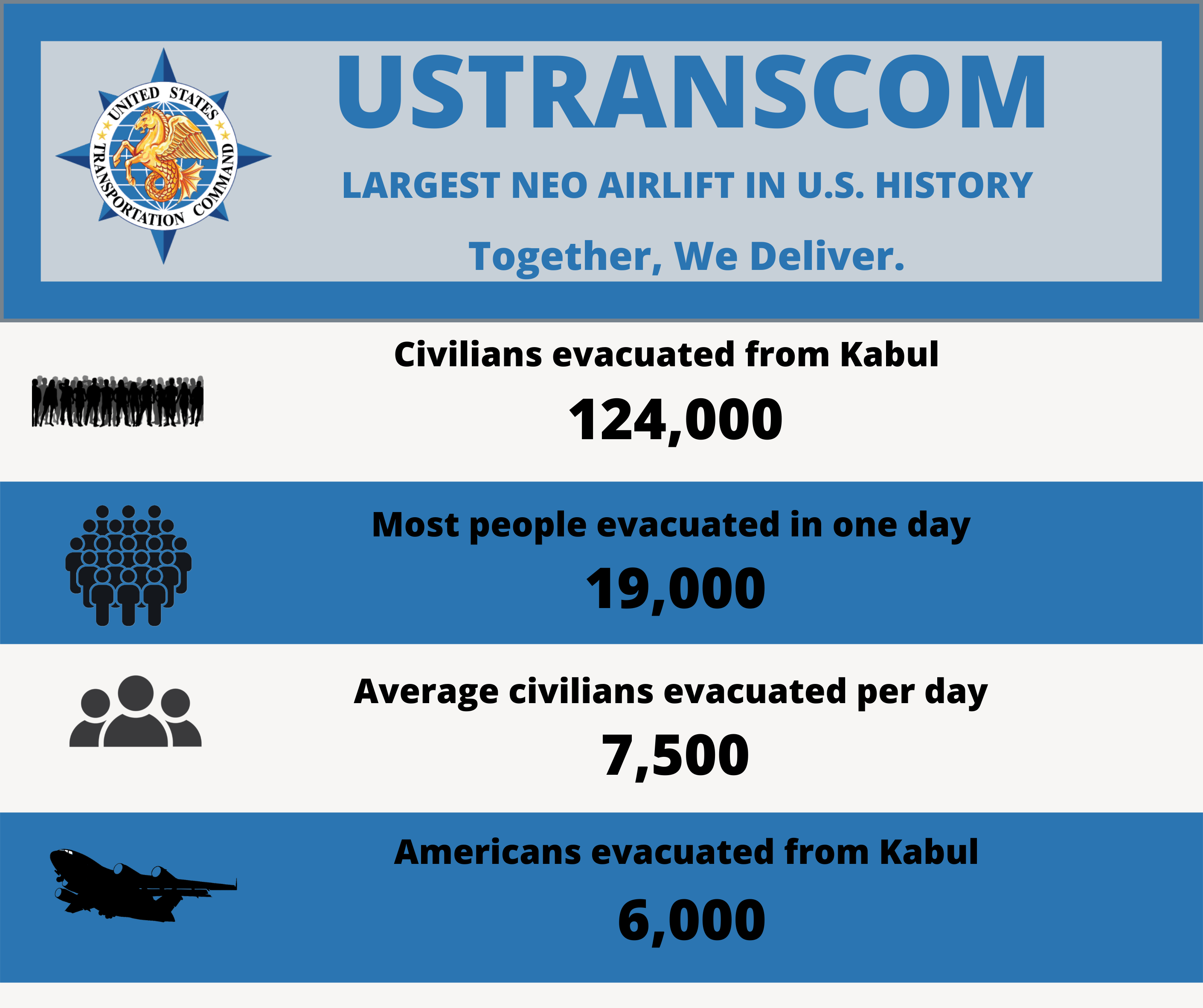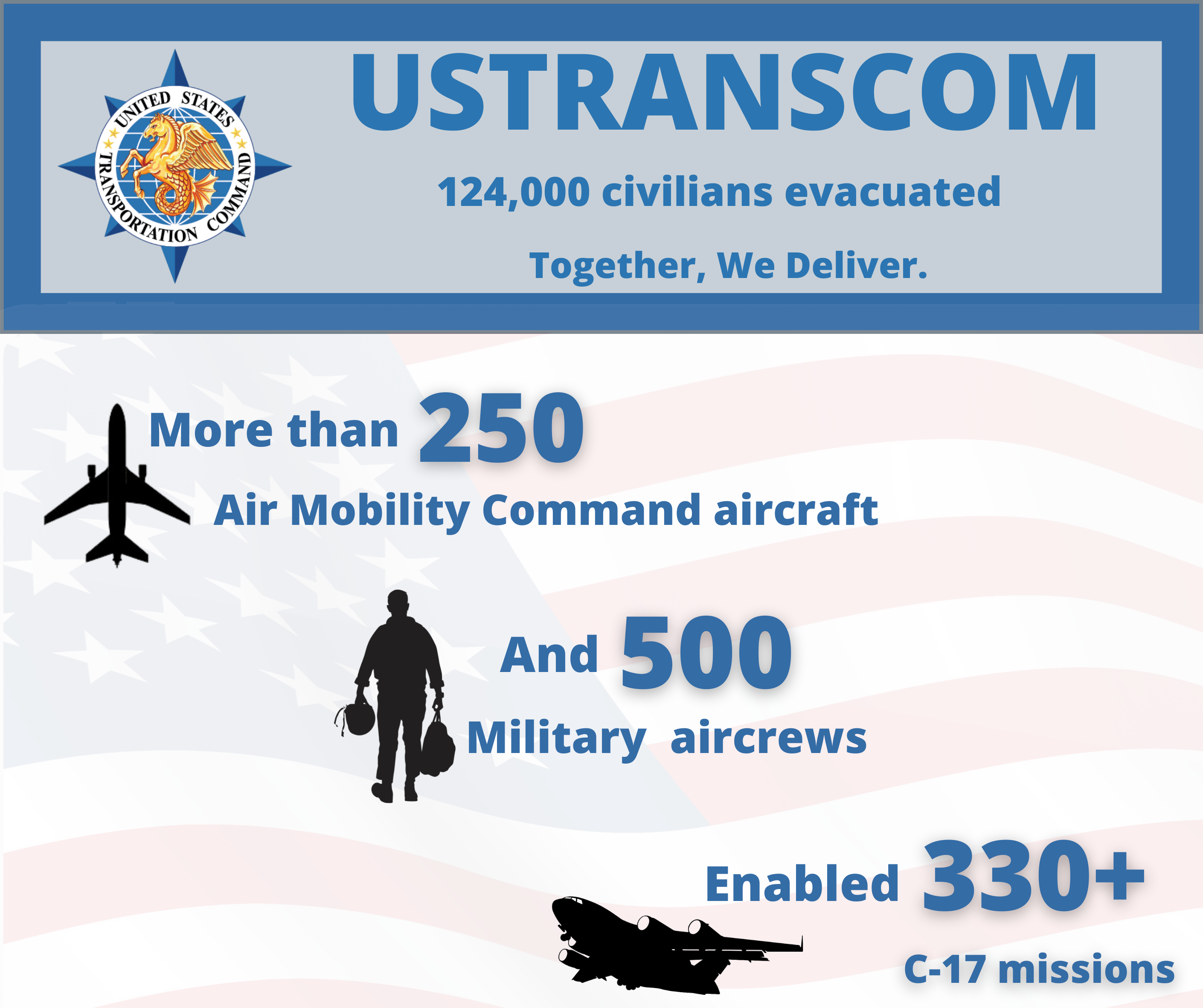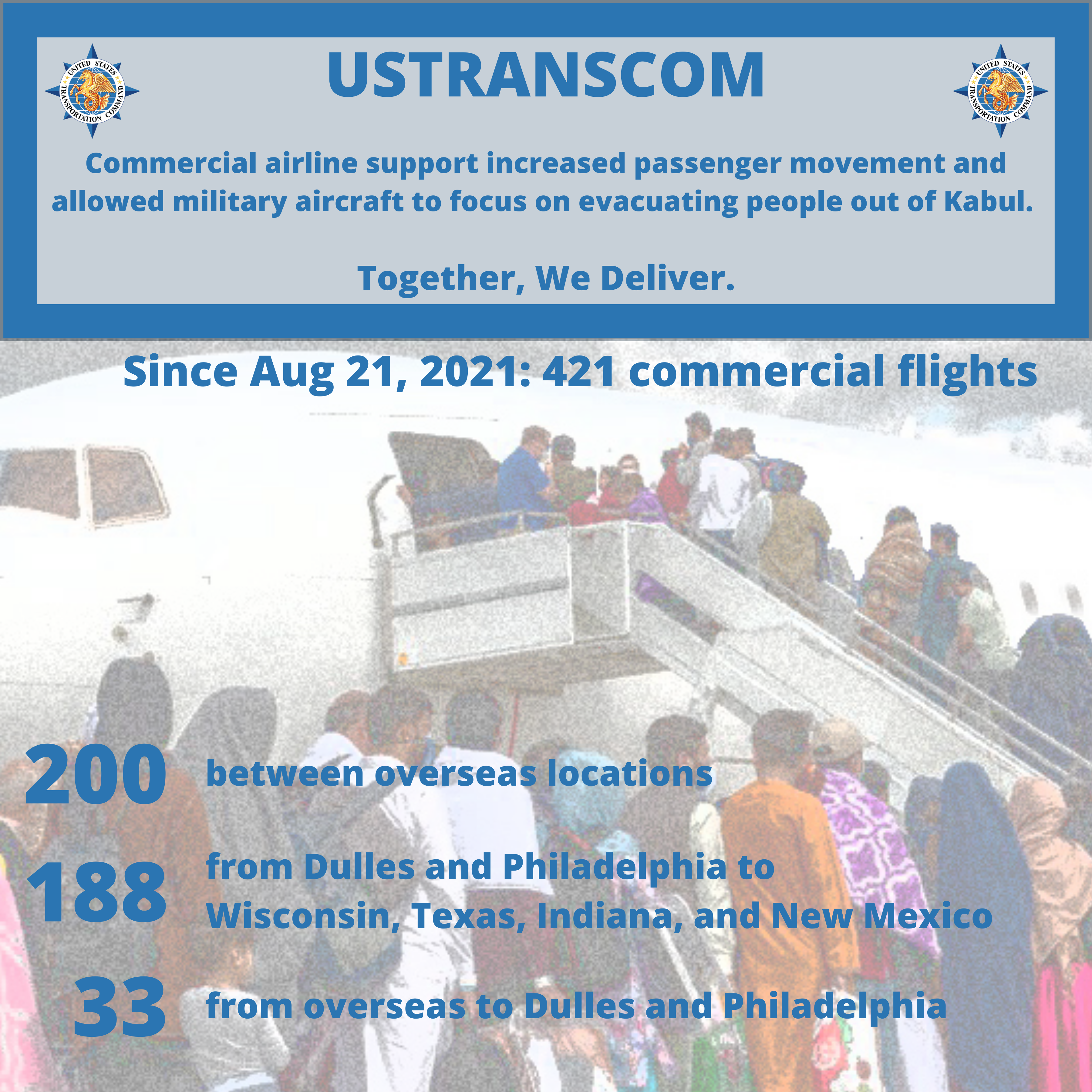Afghanistan Evacuation Support
As the last U.S. service members departed Hamid Karzai International Airport (HKIA) in Kabul, Afghanistan, on Aug. 31, U.S. Transportation Command (TRANSCOM) continued moving evacuees from temporary safe havens onward to the United States. The United States and partnering countries evacuated approximately 124,000 people to safety.
Air Mobility Command, USTRANSCOM’s air component, continues providing airlift support for evacuees. Aircraft include those used for military transportation, such as C-17s and C-130s, and aerial refuelers such as the KC-135s and KC-10s. Approximately 400 active duty, Air National Guard, and Air Force Reserve crews have flown evacuees to safety.
Quotes from U.S. Army Gen. Stephen Lyons, Commander, U.S. Transportation Command
- “From the time TRANSCOM received orders to commence deployment, initial force elements critical to securing HKIA were airborne in less than 3 hours. We immediately commenced NEO operations and continued around the clock over the last 17 days to assist with the safe evacuation of over 120,000 people.”
- “The United States is the only nation capable of rapidly deploying forces and providing non-stop airlift operations at this scale.”
- “I would like to especially thank Air Mobility Command for their impressive role in providing airlift, aeromedical evacuation, aerial refueling, contingency response forces, and a multitude of other critical support. The courage, professionalism, and responsiveness of U.S. Mobility Air forces is impressive beyond measure. The iconic photo of REACH 871 rescuing 823 Afghans underscores both the desperation and fear of the Afghan people, as well as the lifesaving capability of our military providing hope for a new beginning and better future.”
- “I would also like to express the sense of profound pride I have in the creative, determined, and professional way that our forces have overcome challenges. These incredible achievements, this historic airlift, speaks to the humanity of our troops in this mission and the skill and professionalism of our U.S. military.”
Quote from U.S. Marine Corps Gen. Frank McKenzie, Commander, U.S. Central Command
- “Moreover, this evacuation could simply not have been done without the amazing flexibility of U.S. Transportation Command and the airlift provided by the United States Air Force. No other military in the world has anything like it.”
Commercial Partners
Commercial airlines, both from the United States and other countries, have played a vital role in moving Afghanistan evacuees from staging locations onward to the United States. U.S. Transportation Command (USTRANSCOM) recognizes that our ability to respond in times of crisis is inextricably linked to commercial industry.
On Aug. 22, U.S. Secretary of Defense Lloyd J. Austin III ordered USTRANSCOM to activate Stage I of the Civil Reserve Air Fleet (CRAF) to augment support to the Department of State in the evacuation of U.S. citizens, Special Immigrant Visa applicants, and other at-risk individuals from Afghanistan. American Airlines, Atlas Air, Delta Air Lines, Omni Air, Hawaiian Airlines and United Airlines contributed a total of 18 commercial aircraft. The activation of commercial airplanes under CRAF ended on Sept. 12. Our air component, Air Mobility Command (AMC), coordinated flight schedules during the activation and continues to coordinate international and domestic flights relocating evacuees into the United States.
USTRANSCOM consistently communicated with airline leadership to coordinate flight schedules and manage the intricacies of this complex operation. We appreciate the tireless work of the flight crews, aircraft cleaning teams, ground crews and all employees of the airline industry committed to this effort, working with us to safely move our Afghan partners and their families. Our capability to successfully carry out this mission is dependent on the critical capacity industry partners provide in extending our global transportation network. Together, we deliver!
- Between Aug. 22 and Sept. 13, 188 commercial (USTRANSCOM contracted and/or 618th Air Operations Center coordinated) domestic passenger flights were flown in support of relocating evacuees from Afghanistan.
- Between Aug. 21 and Sept. 13, 200 commercial (USTRANSCOM contracted and/or 618th Air Operations Center coordinated) international passenger flights relocating evacuees to the United States were flown.
- Between Aug. 24 and Sept. 9, 33 commercial (USTRANSCOM contracted and/or 618th Air Operations Center coordinated) international passenger flights relocating evacuees from interim locations to Ramstein Air Base were completed.
Latest Updates
On Sept. 12, Stage I of the Civil Reserve Air Fleet (CRAF) activation ended. Commercial airline partners continue to play a vital role in transporting evacuees from staging locations in Europe and the Middle East to the United States.
On Aug. 31, the last U.S. C-17 aircraft departed Kabul marking America’s departure from Afghanistan and the end of the largest non-combatant evacuation operation airlift in history.
On Aug. 26, USTRANSCOM supported the medical evacuation of U.S. servicemembers and Afghan nationals following an attack by the Islamic State Khorasan (known as ISIS-K) at HKIA. USTRANSCOM is the Department of Defense’s single manager for global patient movement. Three C-17s carrying aeromedical evacuation crews and Critical Care Air Transport Teams were launched from Ramstein Air Base, Germany, and Al Udeid Air Base, Qatar, with the first of those taking off only minutes after the incident occurred at HKIA.
On Aug. 22, U.S. Secretary of Defense Lloyd J. Austin III ordered USTRANSCOM to activate Stage I of the Civil Reserve Air Fleet (CRAF) to augment support to the Department of State in the evacuation of U.S. citizens, Special Immigrant Visa applicants, and other at-risk individuals from Afghanistan. CRAF is a National Emergency Preparedness Program designed to augment the Department’s airlift capability and is a core component of USTRANSCOM’s ability to meet national security interests and contingency requirements. American Airlines, Atlas Air, Delta Air Lines, Omni Air, Hawaiian Airlines and United Airlines contributed a total of 18 commercial aircraft.
On Aug. 15, a C-17 flight set a record by carrying 823 passengers from Hamid Karzai International Airport (HKIA) in Kabul, Afghanistan. On average, one military aircraft has departed HKIA every hour.
Articles
USTRANSCOM, industry leaders solidify strategic airlift partnership at CRAF summit
Release #: 20240606-1 Thursday, June 06, 2024SCOTT AIR FORCE BASE, Ill. — U.S. Transportation Command (USTRANSCOM) hosted government and commercial airline leaders June 5, to discuss strategic airlift readiness and to continue strengthening partnerships. USTRANSCOM Deputy Commander Army Lt. Gen. John Sullivan co-chaired the biannual Civil Reserve Air Fleet (CRAF) Executive Working Group (EWG) with Air Mobility Command Deputy …
AMC Announces Additional Awards for Operation Allies Refuge
Release #: 20231108-1 Wednesday, November 08, 2023SCOTT AFB, Ill. — Air Mobility Command will award eight Distinguished Flying Crosses, two Bronze Star Medals, 229 Air Medals and 98 Meritorious Service Medals for actions taken during Operation Allies Refuge. Some of the medals will be presented during a private gathering at the 2023 Airlift Tanker Association Convention, in Grapevine, Texas, Nov. 9, 2023. Those being awarded …
USTRANSCOM’s reserve force charts new era
Release #: 20231023-1 Monday, October 23, 2023SCOTT AIR FORCE BASE, Ill. — U.S. Transportation Command (USTRANSCOM) deactivated its Joint Transportation Reserve Unit (JTRU) during a ceremony on Oct. 21, following three decades of service. The JTRU's mission was to enhance USTRANSCOM's ability to project and sustain military power at a time and place of the nation's choosing. Its deactivation will allow a realignment to a Reserve …
Command interview: Gen. Jacqueline Van Ovost, USTRANSCOM
Release #: 20230323-1 Thursday, March 23, 2023Gen. Van Ovost is the 14th Commander of U.S. Transportation Command, one of 11 combatant commands in the Department of Defense. USTRANSCOM’s mission is to project and sustain military power globally in order to assure our friends and allies, deter potential adversaries, and if necessary, respond to win decisively. Gen. Van Ovost has a diverse operational and training background which …








